Virtual reality
Virtual reality (VR) is a simulated experience that can be similar to or completely different from the real world. Applications of virtual reality can include entertainment (i.e. video games) and educational purposes (i.e. medical or military training). Other, distinct types of VR style technology include augmented reality and mixed reality.
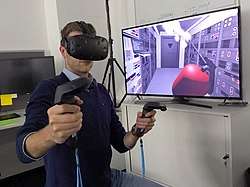
Currently standard virtual reality systems use either virtual reality headsets or multi-projected environments to generate realistic images, sounds and other sensations that simulate a user's physical presence in a virtual environment. A person using virtual reality equipment is able to look around the artificial world, move around in it, and interact with virtual features or items. The effect is commonly created by VR headsets consisting of a head-mounted display with a small screen in front of the eyes, but can also be created through specially designed rooms with multiple large screens. Virtual reality typically incorporates auditory and video feedback, but may also allow other types of sensory and force feedback through haptic technology.
Etymology
"Virtual" has had the meaning of "being something in essence or effect, though not actually or in fact" since the mid-1400s.[1] The term "virtual" has been used in the computer sense of "not physically existing but made to appear by software" since 1959.[1]
In 1938, French avant-garde playwright Antonin Artaud described the illusory nature of characters and objects in the theatre as "la réalité virtuelle" in a collection of essays, Le Théâtre et son double. The English translation of this book, published in 1958 as The Theater and its Double,[2] is the earliest published use of the term "virtual reality". The term "artificial reality", coined by Myron Krueger, has been in use since the 1970s. The term "virtual reality" was first used in a science fiction context in The Judas Mandala, a 1982 novel by Damien Broderick.
Forms and methods
One method by which virtual reality can be realized is simulation-based virtual reality. Driving simulators, for example, give the driver on board the impression of actually driving an actual vehicle by predicting vehicular motion caused by driver input and feeding back corresponding visual, motion and audio cues to the driver.
With avatar image-based virtual reality, people can join the virtual environment in the form of real video as well as an avatar. One can participate in the 3D distributed virtual environment as form of either a conventional avatar or a real video. A user can select own type of participation based on the system capability.
In projector-based virtual reality, modeling of the real environment plays a vital role in various virtual reality applications, such as robot navigation, construction modeling, and airplane simulation. Image-based virtual reality systems have been gaining popularity in computer graphics and computer vision communities. In generating realistic models, it is essential to accurately register acquired 3D data; usually, a camera is used for modeling small objects at a short distance.
Desktop-based virtual reality involves displaying a 3D virtual world on a regular desktop display without use of any specialized positional tracking equipment. Many modern first-person video games can be used as an example, using various triggers, responsive characters, and other such interactive devices to make the user feel as though they are in a virtual world. A common criticism of this form of immersion is that there is no sense of peripheral vision, limiting the user's ability to know what is happening around them.
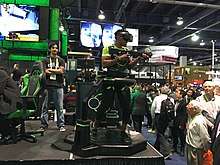
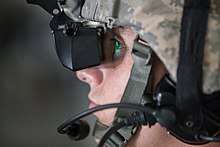
A head-mounted display (HMD) more fully immerses the user in a virtual world. A virtual reality headset typically
includes two small high resolution OLED or LCD monitors which provide separate images for each eye for stereoscopic graphics rendering a 3D virtual world, a binaural audio system, positional and rotational real-time head tracking for six degrees of movement. Options include motion controls with haptic feedback for physically interacting within the virtual world in an intuitive way with little to no abstraction and an omnidirectional treadmill for more freedom of physical movement allowing the user to perform locomotive motion in any direction.
Augmented reality (AR) is a type of virtual reality technology that blends what the user sees in their real surroundings with digital content generated by computer software. The additional software-generated images with the virtual scene typically enhance how the real surroundings look in some way. AR systems layer virtual information over a camera live feed into a headset or smartglasses or through a mobile device giving the user the ability to view three-dimensional images.
Mixed reality (MR) is the merging of the real world and virtual worlds to produce new environments and visualizations where physical and digital objects co-exist and interact in real time.
A cyberspace is sometimes defined as a networked virtual reality.[3]
Simulated reality is a hypothetical virtual reality as truly immersive as the actual reality, enabling an advanced lifelike experience or even virtual eternity.
History
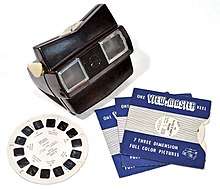
The exact origins of virtual reality are disputed, partly because of how difficult it has been to formulate a definition for the concept of an alternative existence.[4] The development of perspective in Renaissance Europe created convincing depictions of spaces that did not exist, in what has been referred to as the "multiplying of artificial worlds".[5] Other elements of virtual reality appeared as early as the 1860s. Antonin Artaud took the view that illusion was not distinct from reality, advocating that spectators at a play should suspend disbelief and regard the drama on stage as reality.[2] The first references to the more modern concept of virtual reality came from science fiction.
20th century
Morton Heilig wrote in the 1950s of an "Experience Theatre" that could encompass all the senses in an effective manner, thus drawing the viewer into the onscreen activity. He built a prototype of his vision dubbed the Sensorama in 1962, along with five short films to be displayed in it while engaging multiple senses (sight, sound, smell, and touch). Predating digital computing, the Sensorama was a mechanical device. Heilig also developed what he referred to as the "Telesphere Mask" (patented in 1960). The patent application described the device as "a telescopic television apparatus for individual use...The spectator is given a complete sensation of reality, i.e. moving three dimensional images which may be in colour, with 100% peripheral vision, binaural sound, scents and air breezes."[6]
In 1968, Ivan Sutherland, with the help of his students including Bob Sproull, created what was widely considered to be the first head-mounted display system for use in immersive simulation applications. It was primitive both in terms of user interface and visual realism, and the HMD to be worn by the user was so heavy that it had to be suspended from the ceiling. The graphics comprising the virtual environment were simple wire-frame model rooms. The formidable appearance of the device inspired its name, The Sword of Damocles.
1970–1990
The virtual reality industry mainly provided VR devices for medical, flight simulation, automobile industry design, and military training purposes from 1970 to 1990.[7]
David Em became the first artist to produce navigable virtual worlds at NASA's Jet Propulsion Laboratory (JPL) from 1977 to 1984.[8] The Aspen Movie Map, a crude virtual tour in which users could wander the streets of Aspen in one of the three modes (summer, winter, and polygons), was created at the MIT in 1978.
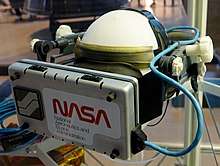
In 1979, Eric Howlett developed the Large Expanse, Extra Perspective (LEEP) optical system. The combined system created a stereoscopic image with a field of view wide enough to create a convincing sense of space. The users of the system have been impressed by the sensation of depth (field of view) in the scene and the corresponding realism. The original LEEP system was redesigned for NASA's Ames Research Center in 1985 for their first virtual reality installation, the VIEW (Virtual Interactive Environment Workstation) by Scott Fisher. The LEEP system provides the basis for most of the modern virtual reality headsets.[9]
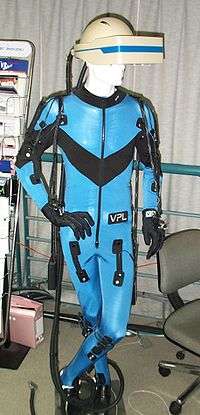
By the 1980s, the term "virtual reality" was popularized by Jaron Lanier, one of the modern pioneers of the field. Lanier had founded the company VPL Research in 1985. VPL Research has developed several VR devices like the DataGlove, the EyePhone, and the AudioSphere. VPL licensed the DataGlove technology to Mattel, which used it to make the Power Glove, an early affordable VR device.
Atari founded a research lab for virtual reality in 1982, but the lab was closed after two years due to the Atari Shock (North American video game crash of 1983). However, its hired employees, such as Tom Zimmerman, Scott Fisher, Jaron Lanier, Michael Naimark, and Brenda Laurel, kept their research and development on VR-related technologies.
In 1988, the Cyberspace Project at Autodesk was the first to implement VR on a low-cost personal computer[10] [11] . The project leader Eric Gullichsen left in 1990 to found Sense8 Corporation and develop the WorldToolKit virtual reality SDK,[12] which offered the first real time graphics with Texture mapping on a PC, and was widely used throughout industry and academia.[13][14]
1990–2000
The 1990s saw the first widespread commercial releases of consumer headsets. In 1992, for instance, Computer Gaming World predicted "affordable VR by 1994".[15]
In 1991, Sega announced the Sega VR headset for arcade games and the Mega Drive console. It used LCD screens in the visor, stereo headphones, and inertial sensors that allowed the system to track and react to the movements of the user's head.[16] In the same year, Virtuality launched and went on to become the first mass-produced, networked, multiplayer VR entertainment system that was released in many countries, including a dedicated VR arcade at Embarcadero Center. Costing up to $73,000 per multi-pod Virtuality system, they featured headsets and exoskeleton gloves that gave one of the first "immersive" VR experiences.[17]
That same year, Carolina Cruz-Neira, Daniel J. Sandin and Thomas A. DeFanti from the Electronic Visualization Laboratory created the first cubic immersive room, the Cave automatic virtual environment (CAVE). Developed as Cruz-Neira's PhD thesis, it involved a multi-projected environment, similar to the holodeck, allowing people to see their own bodies in relation to others in the room.[18][19] Antonio Medina, a MIT graduate and NASA scientist, designed a virtual reality system to "drive" Mars rovers from Earth in apparent real time despite the substantial delay of Mars-Earth-Mars signals.[20]
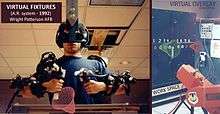
In 1992, Nicole Stenger created Angels, the first real-time interactive immersive movie where the interaction was facilitated with a dataglove and high-resolution goggles. That same year, Louis Rosenberg created the virtual fixtures system at the U.S. Air Force's Armstrong Labs using a full upper-body exoskeleton, enabling a physically realistic mixed reality in 3D. The system enabled the overlay of physically real 3D virtual objects registered with a user's direct view of the real world, producing the first true augmented reality experience enabling sight, sound, and touch.[21][22]
By 1994, Sega released the Sega VR-1 motion simulator arcade attraction,[23][24] in SegaWorld amusement arcades. It was able to track head movement and featured 3D polygon graphics in stereoscopic 3D, powered by the Sega Model 1 arcade system board.[25] Apple released QuickTime VR, which, despite using the term "VR", was unable to represent virtual reality, and instead displayed 360 photographic panoramas.
Nintendo's Virtual Boy console was released in 1995.[26] A group in Seattle created public demonstrations of a "CAVE-like" 270 degree immersive projection room called the Virtual Environment Theater, produced by entrepreneurs Chet Dagit and Bob Jacobson.[27] Forte released the VFX1, a PC-powered virtual reality headset that same year.
In 1999, entrepreneur Philip Rosedale formed Linden Lab with an initial focus on the development of VR hardware. In its earliest form, the company struggled to produce a commercial version of "The Rig", which was realized in prototype form as a clunky steel contraption with several computer monitors that users could wear on their shoulders. The concept was later adapted into the personal computer-based, 3D virtual world program Second Life.[28]
21st century
The 2000s were a period of relative public and investment indifference to commercially available VR technologies.
In 2001, SAS Cube (SAS3) became the first PC-based cubic room, developed by Z-A Production (Maurice Benayoun, David Nahon), Barco, and Clarté. It was installed in Laval, France. The SAS library gave birth to Virtools VRPack. In 2007, Google introduced Street View, a service that shows panoramic views of an increasing number of worldwide positions such as roads, indoor buildings and rural areas. It also features a stereoscopic 3D mode, introduced in 2010.[29]
2010–present
.jpg)
In 2010, Palmer Luckey designed the first prototype of the Oculus Rift. This prototype, built on a shell of another virtual reality headset, was only capable of rotational tracking. However, it boasted a 90-degree field of vision that was previously unseen in the consumer market at the time. Distortion issues arising from the lens used to create the field of vision were corrected for by software written by John Carmack for a version of Doom 3. This initial design would later serve as a basis from which the later designs came.[30] In 2012, the Rift is presented for the first time at the E3 video game trade show by Carmack.[31][32] In 2014, Facebook purchased Oculus VR for what at the time was stated as $2 billion[33] but later revealed that the more accurate figure was $3 billion.[32] This purchase occurred after the first development kits ordered through Oculus' 2012 Kickstarter had shipped in 2013 but before the shipping of their second development kits in 2014.[34] ZeniMax, Carmack's former employer, sued Oculus and Facebook for taking company secrets to Facebook;[32] the verdict was in favour of ZeniMax, settled out of court later.[35]
In 2013, Valve discovered and freely shared the breakthrough of low-persistence displays which make lag-free and smear-free display of VR content possible.[36] This was adopted by Oculus and was used in all their future headsets. In early 2014, Valve showed off their SteamSight prototype, the precursor to both consumer headsets released in 2016. It shared major features with the consumer headsets including separate 1K displays per eye, low persistence, positional tracking over a large area, and fresnel lenses.[37][38] HTC and Valve announced the virtual reality headset HTC Vive and controllers in 2015. The set included tracking technology called Lighthouse, which utilized wall-mounted "base stations" for positional tracking using infrared light.[39][40][41]
.jpg)
In 2014, Sony announced Project Morpheus (its code name for the PlayStation VR), a virtual reality headset for the PlayStation 4 video game console.[42] In 2015, Google announced Cardboard, a do-it-yourself stereoscopic viewer: the user places their smartphone in the cardboard holder, which they wear on their head. Michael Naimark was appointed Google's first-ever 'resident artist' in their new VR division. The Kickstarter campaign for Gloveone, a pair of gloves providing motion tracking and haptic feedback, was successfully funded, with over $150,000 in contributions.[43] Also in 2015, Razer unveiled its open source project OSVR.
.jpg)
By 2016, there were at least 230 companies developing VR-related products. Amazon, Apple, Facebook, Google, Microsoft, Sony and Samsung all had dedicated AR and VR groups. Dynamic binaural audio was common to most headsets released that year. However, haptic interfaces were not well developed, and most hardware packages incorporated button-operated handsets for touch-based interactivity. Visually, displays were still of a low-enough resolution and frame rate that images were still identifiable as virtual.[44]
In 2016, HTC shipped its first units of the HTC Vive SteamVR headset.[45] This marked the first major commercial release of sensor-based tracking, allowing for free movement of users within a defined space.[46] A patent filed by Sony in 2017 showed they were developing a similar location tracking technology to the Vive for PlayStation VR, with the potential for the development of a wireless headset.[47] The Oculus Rift S was released on 20 March 2019.
Technology
Software
The Virtual Reality Modelling Language (VRML), first introduced in 1994, was intended for the development of "virtual worlds" without dependency on headsets.[48] The Web3D consortium was subsequently founded in 1997 for the development of industry standards for web-based 3D graphics. The consortium subsequently developed X3D from the VRML framework as an archival, open-source standard for web-based distribution of VR content.[49] WebVR is an experimental JavaScript application programming interface (API) that provides support for various virtual reality devices, such as the HTC Vive, Oculus Rift, Google Cardboard or OSVR, in a web browser.[50]
Hardware
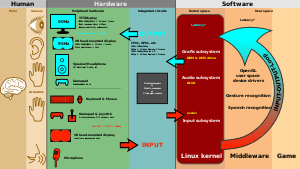
Modern virtual reality headset displays are based on technology developed for smartphones including: gyroscopes and motion sensors for tracking head, body, and hand positions; small HD screens for stereoscopic displays; and small, lightweight and fast computer processors. These components led to relative affordability for independent VR developers, and lead to the 2012 Oculus Rift Kickstarter offering the first independently developed VR headset.[44]
Independent production of VR images and video has increased alongside the development of affordable omnidirectional cameras, also known as 360-degree cameras or VR cameras, that have the ability to record 360 interactive photography, although at relatively low resolutions or in highly compressed formats for online streaming of 360 video.[51] In contrast, photogrammetry is increasingly used to combine several high-resolution photographs for the creation of detailed 3D objects and environments in VR applications.[52][53]
To create a feeling of immersion, special output devices are needed to display virtual worlds. Well-known formats include head-mounted displays or the CAVE. In order to convey a spatial impression, two images are generated and displayed from different perspectives (stereo projection). There are different technologies available to bring the respective image to the right eye. A distinction is made between active (e.g. shutter glasses) and passive technologies (e.g. polarizing filters or Infitec).
Special input devices are required for interaction with the virtual world. These include the 3D mouse, the wired glove, motion controllers, and optical tracking sensors. Controllers typically use optical tracking systems (primarily infrared cameras) for location and navigation, so that the user can move freely without wiring. Some input devices provide the user with force feedback to the hands or other parts of the body, so that the human being can orientate himself in the three-dimensional world through haptics and sensor technology as a further sensory sensation and carry out realistic simulations. This allows for the viewer to have a sense of direction in the artificial landscape. Additional haptic feedback can be obtained from omnidirectional treadmills (with which walking in virtual space is controlled by real walking movements) and vibration gloves and suits.
Virtual reality cameras can be used to create VR photography using 360-degree panorama videos. 360-degree camera shots can be mixed with virtual elements to merge reality and fiction through special effects. VR cameras are available in various formats, with varying numbers of lenses installed in the camera.
Applications
.jpg)
Virtual reality is most commonly used in entertainment applications such as video games and 3D cinema. Consumer virtual reality headsets were first released by video game companies in the early-mid 1990s. Beginning in the 2010s, next-generation commercial tethered headsets were released by Oculus (Rift), HTC (Vive) and Sony (PlayStation VR), setting off a new wave of application development.[54] 3D cinema has been used for sporting events, pornography, fine art, music videos and short films. Since 2015, roller coasters and theme parks have incorporated virtual reality to match visual effects with haptic feedback.[44]
In social sciences and psychology, virtual reality offers a cost-effective tool to study and replicate interactions in a controlled environment.[55] It can be used as a form of therapeutic intervention. For instance, there is the case of the virtual reality exposure therapy (VRET), a form of exposure therapy for treating anxiety disorders such as post traumatic stress disorder (PTSD) and phobias.[56][57][58]
Virtual reality programs are being used in the rehabilitation processes with elderly individuals that have been diagnosed with Alzheimer's disease. This gives these elderly patients the opportunity to simulate real experiences that they would not otherwise be able to experience due to their current state. 17 recent studies with randomized controlled trials have shown that virtual reality applications are effective in treating cognitive deficits with neurological diagnoses.[59] Loss of mobility in elderly patients can lead to a sense of loneliness and depression. Virtual reality is able to assist in making aging in place a lifeline to an outside world that they cannot easily navigate. Virtual reality allows exposure therapy to take place in a safe environment.
In medicine, simulated VR surgical environments were first developed in the 1990s.[60][61][62] Under the supervision of experts, VR can provide effective and repeatable training at a low cost, allowing trainees to recognize and amend errors as they occur.[63] Virtual reality has been used in physical rehabilitation since the 2000s. Despite numerous studies conducted, good quality evidence of its efficacy compared to other rehabilitation methods without sophisticated and expensive equipment is lacking for the treatment of Parkinson's disease.[64] A 2018 review on the effectiveness of mirror therapy by virtual reality and robotics for any type of pathology concluded in a similar way.[65] Another study was conducted that showed the potential for VR to promote mimicry and revealed the difference between neurotypical and autism spectrum disorder individuals in their response to a two-dimensional avatar.[66]
Immersive virtual reality technology with myoelectric and motion tracking control may represent a possible therapy option for treatment-resistant phantom limb pain. Pain scale measurements were taken into account and an interactive 3-D kitchen environment was developed bases on the principles of mirror therapy to allow for control of virtual hands while wearing a motion-tracked VR headset.[67] A systematic search in Pubmed and Embase was performed to determine results that were pooled in two meta-analysis. Meta-analysis showed a significant result in favor of VRT for balance.[68]
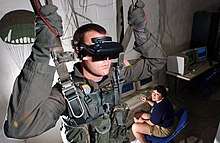
VR can simulate real workspaces for workplace occupational safety and health purposes, educational purposes, and training purposes. It can be used to provide learners with a virtual environment where they can develop their skills without the real-world consequences of failing. It has been used and studied in primary education,[69] anatomy teaching,[70][71] military,[72][73] astronaut training,[74][75][76] flight simulators,[77] miner training,[78] architectural design, driver training[79] and bridge inspection.[80] Immersive VR engineering systems enable engineers to see virtual prototypes prior to the availability of any physical prototypes.[81] Supplementing training with virtual training environments has been claimed to offer avenues of realism in military[82] and healthcare[83] training while minimizing cost.[84] It also has been claimed to reduce military training costs by minimizing the amounts of ammunition expended during training periods.[82]
In the engineering field, VR has proved very useful for both engineering educators and the students. A previously expensive cost in the educational department now being much more accessible due to lowered overall costs, has proven to be a very useful tool in educating future engineers. The most significant element lies in the ability for the students to be able to interact with 3-D models that accurately respond based on real world possibilities. This added tool of education provides many the immersion needed to grasp complex topics and be able to apply them.[85] As noted, the future architects and engineers benefit greatly by being able to form understandings between spatial relationships and providing solutions based on real-world future applications.[86]
The first fine art virtual world was created in the 1970s.[87] As the technology developed, more artistic programs were produced throughout the 1990s, including feature films. When commercially available technology became more widespread, VR festivals began to emerge in the mid-2010s. The first uses of VR in museum settings began in the 1990s, seeing a significant increase in the mid-2010s. Additionally, museums have begun making some of their content virtual reality accessible.[88][89]
Virtual reality's growing market presents an opportunity and an alternative channel for digital marketing.[90] It is also seen as a new platform for e-commerce, particularly in the bid to challenge traditional "brick and mortar" retailers. However, a 2018 study revealed that the majority of goods are still purchased in physical stores.[91]
In the case of education, the uses of virtual reality have demonstrated being capable of promoting higher order thinking, promoting the interest and commitment of students, the acquisition of knowledge, promoting mental habits and understanding that are generally useful within an academic context.[92]
Concerns and challenges
Health and safety
There are many health and safety considerations of virtual reality. A number of unwanted symptoms have been caused by prolonged use of virtual reality,[93] and these may have slowed proliferation of the technology. Most virtual reality systems come with consumer warnings, including: seizures; developmental issues in children; trip-and-fall and collision warnings; discomfort; repetitive stress injury; and interference with medical devices.[94] Some users may experience twitches, seizures or blackouts while using VR headsets, even if they do not have a history of epilepsy and have never had blackouts or seizures before. One in 4,000 people, or .025%, may experience these symptoms. Since these symptoms are more common among people under the age of 20, children are advised against using VR headsets. Other problems may occur in physical interactions with one's environment. While wearing VR headsets, people quickly lose awareness of their real-world surroundings and may injure themselves by tripping over, or colliding with real-world objects.[95]
VR headsets may regularly cause eye fatigue, as does all screened technology, because people tend to blink less when watching screens, causing their eyes to become more dried out.[96] There have been some concerns about VR headsets contributing to myopia, but although VR headsets sit close to the eyes, they may not necessarily contribute to nearsightedness if the focal length of the image being displayed is sufficiently far away.[97]
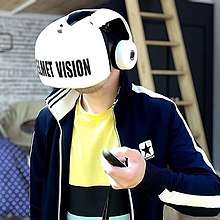
Virtual reality sickness (also known as cybersickness) occurs when a person's exposure to a virtual environment causes symptoms that are similar to motion sickness symptoms.[98] Women are significantly more affected than men by headset-induced symptoms, at rates of around 77% and 33% respectively.[99][100] The most common symptoms are general discomfort, headache, stomach awareness, nausea, vomiting, pallor, sweating, fatigue, drowsiness, disorientation, and apathy.[101] For example, Nintendo's Virtual Boy received much criticism for its negative physical effects, including "dizziness, nausea, and headaches".[102] These motion sickness symptoms are caused by a disconnect between what is being seen and what the rest of the body perceives. When the vestibular system, the body's internal balancing system, does not experience the motion that it expects from visual input through the eyes, the user may experience VR sickness. This can also happen if the VR system does not have a high enough frame rate, or if there is a lag between the body's movement and the onscreen visual reaction to it.[103] Because approximately 25–40% of people experience some kind of VR sickness when using VR machines, companies are actively looking for ways to reduce VR sickness.[104]
Children in virtual reality
The relationship between virtual reality and its underage users is controversial and unexplored. In the meantime, children are becoming increasingly aware of VR, with the number in the USA having never heard of it dropping by half from Autumn 2016 (40%) to Spring 2017 (19%).[105]
Valeriy Kondruk, CEO of VR travel platform Ascape, says the app downloads in March 2020 increased by 60% compared to December 2019 and doubled in comparison with January 2020. According to Kondruk, normally, the busiest month for VR companies is December, which is associated with winter holidays and people spending more time at home.[106]
In early 2016, virtual reality headsets became commercially available with offers from, for example, Facebook (Oculus), HTC and Valve (Vive) Microsoft (HoloLens), and Sony (Morpheus). At the time and to this day, these brands have different age instructions for users, e.g. 12+ or 14+, this indicates a completely self-regulatory policy.[107]
Studies show that young children, compared to adults, may respond cognitively and behaviorally to immersive VR in ways that differ from adults. VR places users directly into the media content, potentially making the experience very vivid and real for children. For example, children of 6–18 years of age reported higher levels of presence and "realness" of a virtual environment compared with adults 19–65 years of age.[108]
Studies on VR consumer behavior or its effect on children and a code of ethical conduct involving underage users are especially needed, given the availability of VR porn and violent content. Related research on violence in video games suggests that exposure to media violence may affect attitudes, behavior, and even self-concept. Self-concept is a key indicator of core attitudes and coping abilities, particularly in adolescents.[109] Early studies conducted on observing versus participating in violent VR games suggest that physiological arousal and aggressive thoughts, but not hostile feelings, are higher for participants than for observers of the virtual reality game.[110]
Experiencing VR by children may further involve simultaneously holding the idea of the virtual world in mind while experiencing the physical world. Excessive usage of immersive technology that has very salient sensory features may compromise children's ability to maintain the rules of the physical world, particularly when wearing a VR headset that blocks out the location of objects in the physical world. Immersive VR can provide users with multisensory experiences that replicate reality or create scenarios that are impossible or dangerous in the physical world. Observations of 10 children experiencing VR for the first time suggested that 8-12-years-old kids were more confident to explore VR content when it was in a familiar situation, e.g. children liked playing in the kitchen context of 'Job simulator'; and that children enjoyed breaking rules by engaging in activities they are not allowed to do in reality, such as setting things on fire.[111]
Privacy
The persistent tracking required by all VR systems makes the technology particularly useful for, and vulnerable to, mass surveillance. The expansion of VR will increase the potential and reduce the costs for information gathering of personal actions, movements and responses.[44]
Conceptual and philosophical concerns
In addition, there are conceptual and philosophical considerations and implications associated with the use of virtual reality. What the phrase "virtual reality" means or refers to can be ambiguous. Mychilo S. Cline argued in 2005 that through virtual reality, techniques will be developed to influence human behavior, interpersonal communication, and cognition.[112][113][114]
Virtual reality in fiction
See also
- 16K resolution
- AlloSphere
- Computer-mediated reality
- Diorama
- Extended reality
- Holographic universe
- Virtual body
- Virtual globe
- Virtual machining
- Virtual taste
References
- "Online Etymology Dictionary".
- Antonin Artaud, The Theatre and its Double Trans. Mary Caroline Richards. (New York: Grove Weidenfeld, 1958).
- "the definition of cyberspace".
- Matthew Schnipper. "Seeing is Believing: The State of Virtual Reality". The Verge. Retrieved 7 March 2017.
- Baltrušaitis, Jurgis; Strachan, W.J. (1977). Anamorphic art. New York: Harry N. Abrams. p. 4. ISBN 9780810906624.
- Holly Brockwell (3 April 2016). "Forgotten genius: the man who made a working VR machine in 1957". Tech Radar. Retrieved 7 March 2017.
- "National Center for Supercomputing Applications: History". The Board of Trustees of the University of Illinois. Archived from the original on 21 August 2015.
- Nelson, Ted (March 1982). "Report on Siggraph '81". Creative Computing.
- Thomas, Wayne (December 2005). "Section 17". "Virtual Reality and Artificial Environments", A Critical History of Computer Graphics and Animation.
- Barlow, John Perry (1990). "Being in Nothingness". Wired.
- "Cyberspace – The New Explorers". 1989. Retrieved 8 August 2019 – via Internet Archive.
- Delaney, Ben (2017). Virtual Reality 1.0 -- The 90s: The Birth of VR. CyberEdge Information Services. p. 40. ISBN 978-1513617039.
- Stoker, Carol. "MARSMAP: AN INTERACTIVE VIRTUAL REALITY MODEL OF THE PATHFINDER LANDING SITE" (PDF). NASA JPL. NASA. Retrieved 7 August 2019.
- Cullen, Chris (13 April 2017). "Pioneering VR Stories Part 1: Idaho National Laboratory In The '90s". Idaho Virtual Reality Council. Retrieved 7 August 2019.
- Engler, Craig E. (November 1992). "Affordable VR by 1994". Computer Gaming World. p. 80. Retrieved 4 July 2014.
- Horowitz, Ken (December 28, 2004). "Sega VR: Great Idea or Wishful Thinking?". Sega-16. Archived from the original on 2010-01-14. Retrieved 21 August 2010.
- "Virtuality". YouTube. Retrieved 21 September 2014.
- Goad, Angela. "Carolina Cruz-Neira | Introductions Necessary". Introductions Necessary. Retrieved 28 March 2017.
- Smith, David (November 24, 2014). "Engineer envisions sci-fi as reality". Arkansas Online. Retrieved 28 March 2017.
- Gonzales, D.; Criswell, D.; Heer, E (1991). Gonzales, D. (ed.). "Automation and Robotics for the Space Exploration Initiative: Results from Project Outreach" (PDF). NASA STI/Recon Technical Report N. 92 (17897): 35. Bibcode:1991STIN...9225258G.
- Rosenberg, Louis (1992). "The Use of Virtual Fixtures As Perceptual Overlays to Enhance Operator Performance in Remote Environments.". Technical Report AL-TR-0089, USAF Armstrong Laboratory, Wright-Patterson AFB OH, 1992.
- Rosenberg, L.B. (1993). "Virtual Fixtures: Perceptual Overlays for Telerobotic Manipulation". In Proc. of the IEEE Annual Int. Symposium on Virtual Reality (1993): pp. 76–82.
- "Arcade Heroes Sega's Wonderful Simulation Games Over The Years – Arcade Heroes". Arcade Heroes. 2013-06-06. Retrieved 20 October 2015.
- "System 16 – Sega Medium Scale Attractions Hardware (Sega)". system16.com. Retrieved 20 October 2015.
- NEXT Generation. June 1995 https://archive.org/stream/nextgen-issue-006/Next_Generation_Issue_006_June_1995#page/n23/mode/2up. Retrieved 20 October 2015 – via archive.org. Missing or empty
|title=(help) - "Nintendo Virtual Boy on theverge.com". Archived from the original on 2014-04-01.
- Dye, Lee (1995-02-22). "Virtual Reality Applications Expand : Imaging: Technology is finding important places in medicine, engineering and many other realms". Los Angeles Times.
- Au, Wagner James. The Making of Second Life, pg. 19. New York: Collins. ISBN 978-0-06-135320-8.
- "Google Street View in 3D: More Than Just an April Fool's Joke". 2010-04-06.
- Rubin, Peter (2014). "Oculus Rift". Wired. 22 (6): 78.
- "E3 12: John Carmack's VR Presentation". Gamereactor. 27 July 2012. Retrieved 20 February 2019.
- Gilbert, Ben (12 December 2018). "Facebook just settled a $500 million lawsuit over virtual reality after a years-long battle — here's what's going on". Business Insider. Retrieved 20 February 2019.
- "Facebook to buy Oculus virtual reality firm for $2B". Associated Press. March 25, 2014. Retrieved March 27, 2014.
- Metz, Cade (2014-03-25). "Facebook Buys VR Startup Oculus for $2 Billion". WIRED. Retrieved 13 March 2017.
- Spangler, Todd (12 December 2018). "ZeniMax Agrees to Settle Facebook VR Lawsuit". Variety. Retrieved 20 February 2019.
- "Not-quite-live bloga : panel discussion with John Carmack, Tim Sweeney, Johan Andersson". The Tech Report. Retrieved 2016-12-14.
- James, Paul (2014-01-30). "30 Minutes Inside Valve's Prototype Virtual Reality Headset: Owlchemy Labs Share Their Steam Dev Days Experience – Road to VR". Road to VR. Retrieved 2016-12-14.
- James, Paul (2013-11-18). "Valve to Demonstrate Prototype VR HMD and Talk Changes to Steam to "Support and Promote VR Games" – Road to VR". Road to VR. Retrieved 2016-12-14.
- "Valve showing off new virtual reality hardware and updated Steam controller next week". The Verge. 2015-02-24. Retrieved 1 March 2015.
- "Valve's VR headset revealed with Oculus-like features". The Verge. 2014-06-03. Retrieved 1 March 2015.
- "HTC Vive: Everything you need to know about the SteamVR headset". Wareable. 2016-04-05. Retrieved 2016-06-19.
- "Sony Announces 'Project Morpheus:' Virtual Reality Headset For PS4".
- "Gloveone: Feel Virtual Reality". Kickstarter. Retrieved 2016-05-15.
- Kelly, Kevin (April 2016). "The Untold Story of Magic Leap, the World's Most Secretive Startup". WIRED. Retrieved 13 March 2017.
- "Vive Shipment Updates – VIVE Blog". VIVE Blog. 2016-04-07. Retrieved 2016-06-19.
- Prasuethsut, Lily (August 2, 2016). "HTC Vive: Everything you need to know about the SteamVR headset". Wareable. Retrieved 13 March 2017.
- Martindale, Jon (15 February 2017). "Vive-like sensor spotted in new Sony patent could make its way to PlayStation VR". Digital Trends. Retrieved 13 March 2017.
- "VRML Virtual Reality Modeling Language". www.w3.org. Retrieved 20 March 2017.
- Brutzman, Don (October 2016). "X3D Graphics and VR" (PDF). web3D.org. Web3D Consortium. Retrieved 20 March 2017.
- "WebVR API". Mozilla Developer Network. Retrieved 2015-11-04.
- Orellana, Vanessa Hand (31 May 2016). "10 things I wish I knew before shooting 360 video". CNET. Retrieved 20 March 2017.
- "Resident Evil 7: The Use of Photogrammetry for VR". 80.lv. Retrieved 20 March 2017.
- Johnson, Leif (13 March 2016). "Forget 360 Videos, Photogrammetric Virtual Reality Is Where It's At – Motherboard". Motherboard. Retrieved 20 March 2017.
- "Comparison of VR headsets: Project Morpheus vs. Oculus Rift vs. HTC Vive". Data Reality. Archived from the original on 20 August 2015. Retrieved 15 August 2015.
- Groom, Victoria; Bailenson, Jeremy N.; Nass, Clifford (2009-07-01). "The influence of racial embodiment on racial bias in immersive virtual environments". Social Influence. 4 (3): 231–248. doi:10.1080/15534510802643750. ISSN 1553-4510. S2CID 15300623.
- Gonçalves, Raquel; Pedrozo, Ana Lúcia; Coutinho, Evandro Silva Freire; Figueira, Ivan; Ventura, Paula (2012-12-27). "Efficacy of Virtual Reality Exposure Therapy in the Treatment of PTSD: A Systematic Review". PLOS ONE. 7 (12): e48469. Bibcode:2012PLoSO...748469G. doi:10.1371/journal.pone.0048469. ISSN 1932-6203. PMC 3531396. PMID 23300515.
- Garrick, Jacqueline; Williams, Mary Beth (2014). Trauma Treatment Techniques: Innovative Trends. London: Routledge. p. 199. ISBN 9781317954934.
- Gerardi, Maryrose (June 2010). "Virtual Reality Exposure Therapy for Post-Traumatic Stress Disorder and Other Anxiety Disorders". Current Psychiatry Reports. 12 (4): 298–305. doi:10.1007/s11920-010-0128-4. PMID 20535592. S2CID 436354.
- "Scopus preview – Scopus – Welcome to Scopus". www.scopus.com. Retrieved 2019-12-09.
- Satava, R. M. (1996). "Medical virtual reality. The current status of the future". Studies in Health Technology and Informatics. 29: 100–106. ISSN 0926-9630. PMID 10163742.
- Rosenberg, Louis; Stredney, Don (1996). "A haptic interface for virtual simulation of endoscopic surgery". Studies in Health Technology and Informatics. 29: 371–387. ISSN 0926-9630. PMID 10172846.
- Stredney, D.; Sessanna, D.; McDonald, J. S.; Hiemenz, L.; Rosenberg, L. B. (1996). "A virtual simulation environment for learning epidural anesthesia". Studies in Health Technology and Informatics. 29: 164–175. ISSN 0926-9630. PMID 10163747.
- Westwood, J.D. Medicine Meets Virtual Reality 21: NextMed / MMVR21. IOS Press. p. 462.
- Dockx, Kim (2016). "=Virtual reality for rehabilitation in Parkinson's disease". Cochrane Database of Systematic Reviews. 12: CD010760. doi:10.1002/14651858.CD010760.pub2. PMC 6463967. PMID 28000926.
- Darbois, Nelly; Guillaud, Albin; Pinsault, Nicolas (2018). "Does Robotics and Virtual Reality Add Real Progress to Mirror Therapy Rehabilitation? A Scoping Review". Rehabilitation Research and Practice. 2018: 6412318. doi:10.1155/2018/6412318. PMC 6120256. PMID 30210873.
- Forbes, Paul A. G.; Pan, Xueni; Hamilton, Antonia F. de C. (2016). "Reduced Mimicry to Virtual Reality Avatars in Autism Spectrum Disorder". Journal of Autism and Developmental Disorders. 46 (12): 3788–3797. doi:10.1007/s10803-016-2930-2. PMC 5110595. PMID 27696183.
- Chau, Brian (Aug 2017). "Immersive virtual reality therapy with myoelectric control for treatment-resistant phantom limb pain: Case report". Psychiatry. 14 (7–8): 3–7. PMC 5880370. PMID 29616149.
- Warnier, Nadieh (Nov 2019). "Effect of virtual reality therapy on balance and walking in children with cerebral palsy: A systematic review". Pediatric Health: 1–17. doi:10.1080/17518423.2019.1683907. PMID 31674852.
- "Online High School In Japan Enters Virtual Reality". blogs.wsj.com. 2016-04-07.
- Moro, Christian; Štromberga, Zane; Raikos, Athanasios; Stirling, Allan (2017-04-17). "The effectiveness of virtual and augmented reality in health sciences and medical anatomy: VR and AR in Health Sciences and Medical Anatomy". Anatomical Sciences Education. 10 (6): 549–559. doi:10.1002/ase.1696. PMID 28419750.
- Moro, Christian; Štromberga, Zane; Stirling, Allan (2017-11-29). "Virtualisation devices for student learning: Comparison between desktop-based (Oculus Rift) and mobile-based (Gear VR) virtual reality in medical and health science education". Australasian Journal of Educational Technology. 33 (6). doi:10.14742/ajet.3840. ISSN 1449-5554.
- "DSTS: First immersive virtual training system fielded". www.army.mil. Retrieved 2017-03-16.
- "Virtual reality used to train Soldiers in new training simulator".
- "NASA shows the world its 20-year virtual reality experiment to train astronauts: The inside story – TechRepublic". TechRepublic. Retrieved 2017-03-15.
- James, Paul (2016-04-19). "A Look at NASA's Hybrid Reality Astronaut Training System, Powered by HTC Vive – Road to VR". Road to VR. Retrieved 2017-03-15.
- "How NASA is Using Virtual and Augmented Reality to Train Astronauts". Unimersiv. 2016-04-11. Retrieved 2017-03-15.
- Dourado, Antônio O.; Martin, C.A. (2013). "New concept of dynamic flight simulator, Part I". Aerospace Science and Technology. 30 (1): 79–82. doi:10.1016/j.ast.2013.07.005.
- "Virtual Reality in Mine Training". www.cdc.gov. Retrieved 2018-11-09.
- "How Virtual Reality Military Applications Work". 2007-08-27.
- Omer; et al. (2018). "Performance evaluation of bridges using virtual reality". Proceedings of the 6th European Conference on Computational Mechanics (ECCM 6) & 7th European Conference on Computational Fluid Dynamics (ECFD 7), Glasgow, Scotland.
- Seu; et al. (2018). "Use of gaming and affordable VR technology for the visualization of complex flow fields". Proceedings of the 6th European Conference on Computational Mechanics (ECCM 6) & 7th European Conference on Computational Fluid Dynamics (ECFD 7), Glasgow, Scotland.
- Shufelt, Jr., J.W. (2006) A Vision for Future Virtual Training. In Virtual Media for Military Applications (pp. KN2-1 – KN2-12). Meeting Proceedings RTO-MP-HFM-136, Keynote 2. Neuilly-sur-Seine, France: RTO. Available from: http://www.rto.nato.int/abstracts.asp Archived 2007-06-13 at the Wayback Machine
- Bukhari, Hatim; Andreatta, Pamela; Goldiez, Brian; Rabelo, Luis (2017-01-01). "A Framework for Determining the Return on Investment of Simulation-Based Training in Health Care". INQUIRY: The Journal of Health Care Organization, Provision, and Financing. 54: 0046958016687176. doi:10.1177/0046958016687176. ISSN 0046-9580. PMC 5798742. PMID 28133988.
- Smith, Roger (2010-02-01). "The Long History of Gaming in Military Training". Simulation & Gaming. 41 (1): 6–19. doi:10.1177/1046878109334330. ISSN 1046-8781. S2CID 13051996.
- Abulrub, Abdul-Hadi G.; Attridge, Alex N.; Williams, Mark A. (April 2011). "Virtual reality in engineering education: The future of creative learning". 2011 IEEE Global Engineering Education Conference (EDUCON): 751–757. doi:10.1109/EDUCON.2011.5773223. ISBN 978-1-61284-642-2.
- Makaklı, Elif Süyük (2019). "STEAM approach in architectural education". SHS Web of Conferences. 66: 01012. doi:10.1051/shsconf/20196601012. ISSN 2261-2424.
- Mura, Gianluca (2011). Metaplasticity in Virtual Worlds: Aesthetics and Semantic Concepts. Hershey, Pennsylvania: Information Science Reference. p. 203. ISBN 978-1-60960-077-8.
- "Virtual reality at the British Museum: What is the value of virtual reality environments for learning by children and young people, schools, and families? – MW2016: Museums and the Web 2016".
- "Extending the Museum Experience with Virtual Reality". 18 March 2016.
- Shirer, Michael; Torchia, Marcus (February 27, 2017). "Worldwide Spending on Augmented and Virtual Reality Forecast to Reach $13.9 Billion in 2017, According to IDC". International Data Corporation. International Data Corporation. Archived from the original on March 19, 2018. Retrieved March 16, 2018.
- "How Technology is Expanding the Scope of Online Commerce Beyond Retail". www.walkersands.com. Retrieved 2018-08-31.
- Sáez-López, José-Manuel; García, María Luisa Sevillano-García; Pascual-Sevillano, María de los Ángeles (2019). "Aplicación del juego ubicuo con realidad aumentada en Educación Primaria". Comunicar (in Spanish). 27 (61): 71–82. doi:10.3916/C61-2019-06. ISSN 1134-3478.
- Lawson, B. D. (2014). Motion sickness symptomatology and origins. Handbook of Virtual Environments: Design, Implementation, and Applications, 531-599.
- "Oculus Rift Health and Safety Notice" (PDF). Retrieved 13 March 2017.
- Fagan, Kaylee. "Here's what happens to your body when you've been in virtual reality for too long". Business Insider. Retrieved 5 September 2018.
- Mukamal, Reena (2017-02-28). "Are Virtual Reality Headsets Safe for Eyes?". American Academy of Ophthalmology. Retrieved 11 September 2018.
- Langley, Hugh (2017-08-22). "We need to look more carefully into the long-term effects of VR". Wareable.com. Retrieved 11 September 2018.
- Kiryu, T; So, RH (25 September 2007). "Sensation of presence and cybersickness in applications of virtual reality for advanced rehabilitation". Journal of Neuroengineering and Rehabilitation. 4: 34. doi:10.1186/1743-0003-4-34. PMC 2117018. PMID 17894857.
- Munafo, Justin; Diedrick, Meg; Stoffregen, Thomas A. (3 December 2016). "The virtual reality head-mounted display Oculus Rift induces motion sickness and is sexist in its effects". Experimental Brain Research. 235 (3): 889–901. doi:10.1007/s00221-016-4846-7. PMID 27915367. S2CID 13740398.
- Park, George D.; Allen, R. Wade; Fiorentino, Dary; Rosenthal, Theodore J.; Cook, Marcia L. (5 November 2016). "Simulator Sickness Scores According to Symptom Susceptibility, Age, and Gender for an Older Driver Assessment Study". Proceedings of the Human Factors and Ergonomics Society Annual Meeting. 50 (26): 2702–2706. doi:10.1177/154193120605002607. S2CID 111310621.
- Hicks, Jamison S.; Durbin, David B. (June 2011). "ARL-TR-5573: A Summary of Simulator Sickness Ratings for U.S. Army Aviation Engineering Simulators" (PDF). US Army Research Laboratory.
- Frischling, Bill (October 25, 1995). "Sideline Play". The Washington Post. p. 11 – via ProQuest.
|access-date=requires|url=(help) - Caddy, Becca (2016-10-19). "Vomit Reality: Why VR makes some of us feel sick and how to make it stop". Wareable.com. Retrieved 11 September 2018.
- Samit, Jay. "A Possible Cure for Virtual Reality Motion Sickness". Fortune.com. Retrieved 11 September 2018.
- Yamada-Rice, Dylan; Mushtaq, Faisal; Woodgate, Adam; Bosmans, D.; Douthwaite, A.; Douthwaite, I.; Harris, W.; Holt, R.; Kleeman, D. (2017-09-12). "Children and Virtual Reality: Emerging Possibilities and Challenges" (PDF). digilitey.eu. Retrieved 2020-04-27.
- "Is virtual travel here to stay, even after the pandemic subsides?". Travel. 2020-04-20. Retrieved 2020-04-27.
- Madary, Michael; Metzinger, Thomas K. (2016). "Real Virtuality: A Code of Ethical Conduct. Recommendations for Good Scientific Practice and the Consumers of VR-Technology". Frontiers in Robotics and AI. 3. doi:10.3389/frobt.2016.00003. ISSN 2296-9144.
- Bailey, Jakki O.; Bailenson, Jeremy N. (2017-01-01), Blumberg, Fran C.; Brooks, Patricia J. (eds.), "Chapter 9 – Immersive Virtual Reality and the Developing Child", Cognitive Development in Digital Contexts, Academic Press, pp. 181–200, doi:10.1016/B978-0-12-809481-5.00009-2, ISBN 978-0-12-809481-5, retrieved 2020-04-27
- Funk, Jeanne B.; Buchman, Debra D. (1996-06-01). "Playing Violent Video and Computer Games and Adolescent Self-Concept". Journal of Communication. 46 (2): 19–32. doi:10.1111/j.1460-2466.1996.tb01472.x. ISSN 0021-9916.
- Calvert, Sandra L.; Tan, Siu-Lan (January 1994). "Impact of virtual reality on young adults' physiological arousal and aggressive thoughts: Interaction versus observation". Journal of Applied Developmental Psychology. 15 (1): 125–139. doi:10.1016/0193-3973(94)90009-4. ISSN 0193-3973.
- Yamada-Rice, Dylan; Mushtaq, Faisal; Woodgate, Adam; Bosmans, D.; Douthwaite, A.; Douthwaite, I.; Harris, W.; Holt, R.; Kleeman, D. (2017-09-12). "Children and Virtual Reality: Emerging Possibilities and Challenges" (PDF). digilitey.eu. Retrieved 2020-04-27.
- Cline, Mychilo Stephenson (2005). Power, Madness, & Immortality: the Future of Virtual Reality. Virtualreality.universityvillagepress.com. Retrieved 2009-10-28.
- "The Future of Virtual Reality with Mychilo Cline " Introduction to the Future of Virtual Reality". Virtualreality.universityvillagepress.com. Retrieved 2009-10-28.
- "Power, Madness and Immortality". KurzweilAI. Retrieved 28 March 2017.
Further reading
- Choi, SangSu, Kiwook Jung, and Sang Do Noh (2015). "Virtual reality applications in manufacturing industries: Past research, present findings, and future directions" (PDF). Concurrent Engineering. 1063293X14568814.CS1 maint: multiple names: authors list (link)
External links
| Wikimedia Commons has media related to Virtual reality. |
- Isaac, Joseph (2016). "Step into a new world – Virtual Reality (VR)". Retrieved 2 July 2016. Basic Concepts of Virtual Reality along with Research Challenges explained in simple words.
- Mixed Reality Scale – Milgram and Kishino's (1994) Virtuality Continuum paraphrase with examples.
- Drummond, Katie (2014). "The Rise and Fall and Rise of Virtual Reality". The Verge. Retrieved 15 November 2014. Interviews on the history and future of virtual reality by leaders in the field.
- "Virtual reality in human-system interaction".

